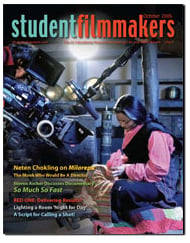Check out this
article in the print edition of StudentFilmmakers
Magazine, October 2006. Click
here to get a copy and to subscribe >>
 Directing
for the Cut Directing
for the Cut
Change of Distance, Change of Angle, and
Action within the Scene
by George Avgerakis
It has often been said the best film directors came from a previous
career as editors. One of the most valuable lessons a director
can learn in the edit room is how to �direct for the cut.� The
art of film is made of two parts: what happens in the scene and
what happens between the scenes, that is the cut (or transition).
Cutting establishes momentum, rhythm, action, suspense and drama.
Regardless of the skill of the editor, directors who directed
for the cut inevitably achieve higher degrees of success and artistic
achievement.
Directing for the cut requires knowledge of the three basic ingredients
of a good cut. These are change of distance, change of angle,
and action within the scene. A cut that has all three is said
to be a �well-directed cut.�
Change of distance, between Shot A and Shot B can be represented
by a physical move of the camera from close to far (or vice versa)
and/or a change of lens focal length. Obviously, if a cut uses
only change of distance on a subject, which is otherwise unchanging,
the cut will likely be a wretched failure. Add, however, change
of angle, and the cut improves.
Change of angle means that the position of the camera, with regard
to the subject(s) moves from Shot A to Shot B. This change can
be measured in feet or meters past the subject from, say, left
to right, or degrees of arc around the subject, say 30 degrees
clockwise or counter-clockwise. The final ingredient of a well-directed
cut is action within the scene.
Let�s suppose we have a scene of a lover�s quarrel. The woman
gets upset with her man and slaps him across the face. This is
great action for a cut. If the slap begins in Shot A, the editor
can carry the action all the way to � and through � the painful
impact, and then CUT to Shot B sometime during the impact. If,
at the same time, the director had supplied a change of distance
and angle between the two shots, the viewer�s eye is treated to
a smooth, emotional experience.
Directors have to be wise enough to give their editor enough latitude
to decide the exactly right moment to affect the cut. Often an
editor will choose to overlap the action. For instance, in the
slap, Shot A may carry through several frames past the impact,
while Shot B will begin several frames before the impact. The
subliminal effect of such a cut is to elongate the moment of pain
and to cause the audience to experience a slight hesitation or
emphasis on the key action � the slap.
The opposite effect can be created by trimming the end Shot A
slightly before the impact and the beginning of Shot B slightly
after the impact. This would create a nearly humorous effect,
where the audience anticipates the slap, sees the result, but
doesn�t experience the actual �sting!�.
A wise director, wishing to leave such delicate decisions until
after the tension of filming is over, will provide the editor
with an abundance of footage both before and after the key action
in every take. That is why beginning actors are told to wait until
they hear, �Cut!� before they stop acting. The reason is to extend
the action of the scene well past the point where the director
anticipates the cut to occur.
Incidentally, there is a weird kind of effect you can accidentally
create.
Okay, we know the three essentials; so let�s put them into practice
on a real scene.
In first year film studies, I often used to send the class out
in teams of four to five on just this exercise. You can try it
with your friends or crew as practice or adapt it to any current
project. The scene is a simple. Two people sit on opposite sides
of a table. They have some conversation and then slap their hands
together in a �high five.� That�s it.
This scene brings up another key directorial �rule,� which is,
�Don�t cut across the line.� In this rule, there is an imaginary
line between any two people in a scene. When shooting 2-shots
within such a scene, keep the camera on one side of this line.
That means, you have roughly 179 degrees of rotation around the
two subjects. This would include an equal 2-shot and a pair of
over-the-shoulder shots of each subject.
If you violate the rule and try to cut the two 2-shots together,
the result will be a weird jump cut where the two subjects will
instantly reverse position on the screen! Believe it or not, I
have seen such a bad cut in a recent feature film. Worse yet,
I allowed one to occur in a film I shot!
Now, when you direct the exercise, be sure to shoot the entire
scene as a master shot, showing the entire room. This is also
called an �establishing shot,� because it establishes, for the
viewer, the scene in which your action will take place. It�s good
to start with the master shot for a lot of reasons, the most important
of which is time and money. If something goes bad during the shoot,
and you have to abandon the location, you have at least something
you can use!
Continued
on Next Page...
|
